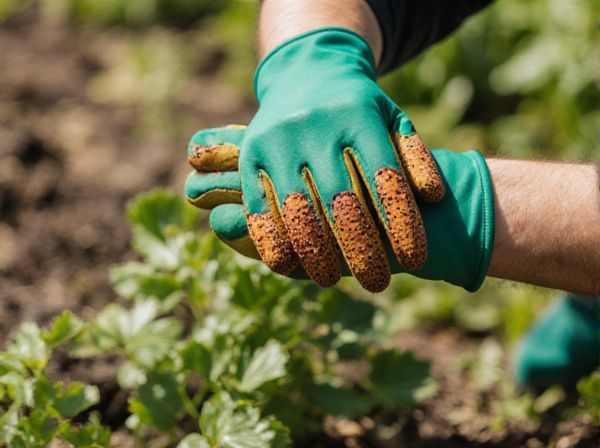
Anthracnose vs Alternaria Illustration
Anthracnose and Alternaria are fungal diseases that severely affect various crops, causing leaf spots, fruit rot, and defoliation. Anthracnose is characterized by dark, sunken lesions typically found on stems, leaves, and fruits, while Alternaria produces concentric ring spots mainly on leaves and fruits. Effective disease management involves crop rotation, resistant cultivars, and timely fungicide applications to reduce yield losses.
Table of Comparison
| Disease | Pathogen | Hosts | Symptoms | Distribution | Control Methods |
|---|---|---|---|---|---|
| Anthracnose | Fungi from Colletotrichum genus | Various plants including fruits, vegetables, and ornamentals | Dark, sunken lesions on leaves, stems, and fruits | Worldwide, especially in warm, humid climates | Fungicides, resistant varieties, crop rotation, sanitation |
| Alternaria | Fungi from Alternaria genus | Wide range of plants including cereals, vegetables, and ornamentals | Brown to black leaf spots with concentric rings | Worldwide, favors warm and dry conditions | Fungicides, resistant cultivars, good air circulation, crop rotation |
Anthracnose vs Alternaria: Key Differences
Anthracnose and Alternaria are fungal diseases that primarily affect plants but differ in symptoms and causative pathogens; Anthracnose, caused by Colletotrichum species, produces sunken, dark lesions on leaves and fruits, while Alternaria, caused by Alternaria species, creates concentric ring spots with a target-like appearance. Anthracnose often results in fruit rot and leaf blight during warm, wet conditions, whereas Alternaria thrives in humid environments, leading to leaf spots and stem cankers that impede photosynthesis and plant growth. Effective management of both diseases requires targeted fungicide applications and cultural practices, but accurate identification is crucial due to their distinct pathogen biology and disease progression.
Understanding the Pathogens Behind Anthracnose and Alternaria
Anthracnose is caused by fungi in the Colletotrichum genus, primarily affecting leaves, stems, flowers, and fruits with dark, sunken lesions that reduce plant vigor and yield. Alternaria, caused by species such as Alternaria solani and Alternaria alternata, leads to leaf spots, blights, and fruit rots, characterized by concentric rings and rapid tissue necrosis. Understanding the distinct lifecycle, infection processes, and environmental preferences of Colletotrichum and Alternaria fungi is critical for effective disease management in crops.
Common Host Plants Affected by Anthracnose and Alternaria
Anthracnose primarily affects hardwood trees such as oak, maple, and sycamore, along with important crops like beans, cucumbers, and tomatoes, causing dark, sunken lesions on leaves and stems. Alternaria targets a wide variety of plants including vegetables like tomatoes, carrots, and potatoes, as well as ornamental plants, leading to leaf spots, blights, and fruit rot. Both diseases significantly impact agricultural productivity by reducing plant vigor and yield in their common host plants.
Visual Symptoms: Anthracnose vs Alternaria
Anthracnose presents as irregularly shaped, dark brown to black lesions with a distinct, sunken appearance on leaves, stems, and fruits, often showing concentric rings or water-soaked margins. Alternaria manifests through small, circular to oval spots with concentric rings that create a target-like pattern, typically dark brown to black, primarily on leaves and fruits. Both diseases cause leaf yellowing and defoliation but vary in lesion morphology and progression rate.
How Anthracnose and Alternaria Spread in the Garden
Anthracnose spreads in the garden primarily through water splash from rain or irrigation, infecting leaves, stems, and fruits by entering through wounds or natural openings. Alternaria disperses via airborne spores that land on plant surfaces, often thriving in warm, humid conditions and infecting plants through leaf spots or stem lesions. Both fungi survive in plant debris, making sanitation and crop rotation critical for controlling their spread.
Environmental Conditions Favoring Anthracnose and Alternaria
Anthracnose thrives in warm, humid environments with frequent rainfall or prolonged leaf wetness, often appearing during spring and early summer in temperate regions. In contrast, Alternaria favors dry, warm conditions with high temperatures and moderate humidity, frequently worsening during drought stress or periods of poor air circulation. Both pathogens require specific microclimates on plant surfaces, but their distinct environmental preferences influence disease management and crop susceptibility.
Preventative Measures for Anthracnose and Alternaria
Effective preventative measures for anthracnose include applying fungicides early in the growing season, removing infected plant debris, and ensuring proper spacing for air circulation to reduce moisture buildup. For Alternaria, crop rotation, resistant plant varieties, and maintaining balanced soil nutrition are essential strategies to minimize infection risk. Both diseases benefit from strict sanitation practices and monitoring environmental conditions that favor fungal growth.
Organic and Chemical Control Options
Anthracnose and Alternaria are fungal diseases affecting various crops, controlled organically with copper-based fungicides and neem oil for their antifungal properties. Chemical control involves synthetic fungicides such as chlorothalonil and mancozeb, effective in managing these pathogens by inhibiting spore germination and mycelial growth. Crop rotation, resistant varieties, and proper sanitation enhance these control measures by reducing inoculum sources and environmental conditions favorable to infection.
Managing Infected Plants: Best Practices
Managing anthracnose and alternaria infections in plants involves prompt removal of affected leaves and fruits to reduce pathogen spread. Applying fungicides containing chlorothalonil or copper-based compounds during early infection stages enhances disease control effectiveness. Maintaining proper plant spacing and ensuring adequate air circulation minimizes humidity, limiting fungal development and promoting plant health.
Long-Term Strategies for Disease-Resistant Gardens
Anthracnose and Alternaria are fungal diseases that severely impact plant health, necessitating long-term strategies for disease-resistant gardens. Incorporating disease-resistant plant varieties and rotating crops minimize fungal spread and reduce pathogen buildup in soil. Implementing proper sanitation, improving air circulation, and applying targeted fungicides at early infection stages fortify garden resilience against these persistent diseases.
Anthracnose vs Alternaria Infographic

 gardendif.com
gardendif.com